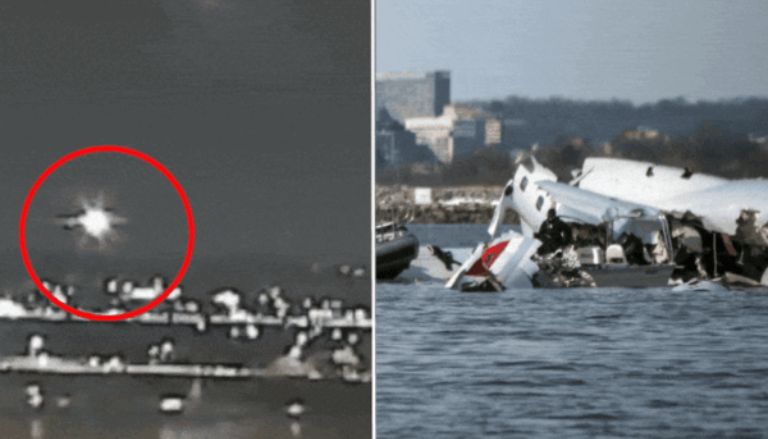At 8.45 p.m. on Wednesday (1.45 a.m. GMT, Thursday), American Eagle Flight 5342 from Wichita, Kansas, descended peacefully into Washington’s Ronald Reagan National Airport.
The sky were clear, the wind was light, and among the 60 passengers were some top young US figure skaters who had recently completed a training camp on Midwest ice rinks.
A webcam positioned over the John F. Kennedy Center on the other side of the Potomac River acquired grainy footage of the Bombardier CRJ-701’s flashing wing lights as it approached to land.
The beacon lights of another aircraft, a US Army UH-60 Black Hawk flying low on a training mission, are also visible in the footage.
At 8.47 p.m., the two dots of light can be seen for a second on their apparent collision trajectory.
A recording from the air traffic control tower captures a frightened message to the helicopter’s operators, identified as call sign PAT25.
“PAT25, do you have a CRJ in sight?” “PAT25, go behind the CRJ,” a controller says.
However, the pilots of the Black Hawk, which carried three soldiers, were unable to respond.
A sudden orange explosion lights up the night over Runway 33, seconds after the controller’s word is relayed, according to dashcam footage from a passing automobile.
The passenger airliner may be seen falling from the sky.
“Oh God,” says the car’s driver, Ari Schulman, who was on his way home after work. “Oh my God.”
There are also gasps from air traffic control: “Oh, oh my God,” one controller exclaims, her voice breaking.
Flight path data shows that the passenger jet’s nose collided with the helicopter’s port side, dumping the blazing wreckage of both aircraft into the river below.
“Tower, did you see that?” another adjacent aircraft calls in via radio. “Crash, crash, crash, this is an alert three,” shouts an air traffic controller, before launching a mad dash to divert landing planes away from Runway 33.
“I saw a fireball and then it disappeared. I have not seen anything since they hit the water. But it was a CRJ and a helicopter that collided.”
Rescuers rushed to the river to look for survivors among the 67 persons who had fallen into the black water.
Inflatable rescue boats were thrown into the Potomac from a location on the George Washington Parkway just north of the airport, and first responders set up light towers from the beach to illuminate the area around the collision scene.
At least a half-dozen boats were combing the dark water with search lights.
Responders performing the search and rescue operations encountered “extremely rough” conditions in the river, according to an official early Thursday.
Both the chopper and the plane were upside down in the sea, and the passenger jet had been shattered into three parts.
By 7 a.m., more than thirty bodies had been recovered from the river, which has current water temperatures of 2C (35.6F) after many days of freezing weather.
Authorities on the Potomac River’s banks requested that media teams and passersby turn down their cameras so that boats could focus on the water.
The stench of fuel wafted up from the accident site as wreckage floated on the surface, according to reporters.
“We don’t know if there are survivors,” DC Fire Chief John Donnelly stated, adding that 300 rescuers were working on the river.
Families of Flight 5342 victims gathered at a terminal at Reagan National Airport this morning, hoping for word of their loved ones.
Hamaad Raza, who was waiting for his wife, said he had lost communication with her after she texted him that she was entering the property.
“[I’m] just praying that someone is pulling her out of the river right now,” he told CNN affiliate WUSA.
“That’s all I can pray for, I’m just praying to God.”
None of the texts he sent in response to his wife’s last message, “landing in 20 minutes,” were delivered, he said.
On Thursday morning, first responders set up a small, temporary morgue near the river’s edge to serve as a base.
Helicopters soared overhead, their powerful searchlights probing the murky waters, while emergency vehicles illuminated the banks of the Potomac in a long line of blinking red lights.
At 7.30 a.m., Mr. Donnelly told a news conference that he did not believe there were any survivors. “We are now at a point where we are switching from a rescue operation to a recovery operation,” he informed me.
Robert Isom, CEO of American Airlines, said he has no idea why the helicopter was in the jet’s route.
“This is devastating,” he said. “Our focus right now is to do everything we can to support everyone involved” .
Following the crash, National Airport closed for the night, routing traffic to Dulles or Baltimore’s Thurgood Marshall Airport.
Tass, Russia’s national news agency, reported that high-profile figure skaters from the country were on board the American Airlines plane, including Yevgenia Shishkova and Vadim Naumov, who won the world championships in 1999.
Their 23-year-old son Maxim competed for the United States in singles and was long trained by his parents.
Roger Marshall, a Republican senator from Kansas, expressed “heartbreak beyond measure” following the tragedy.
“When one person dies, it’s a tragedy, but when many, many, many people die, it’s an unbearable sorrow.”
By 11 a.m., Washington National Airport had reopened, and attention had shifted to what had caused the catastrophe.
In a late-morning press conference, the president accused diversity hires of making the US aviation system hazardous.
As the afternoon progressed, scores of divers were spotted entering the water near the crash scene in an effort to rescue the bodies of the victims.
Kristi Noem, Homeland Security Director, stated that every available US Coast Guard resource has been dispatched to assist with recovery efforts.
The bodies of the three servicemen on board the military chopper were discovered, and their remains will be stored at an air force installation in Delaware, officials said. Their identity has not been revealed.
According to a person familiar with the conversation, the passenger jet changed course shortly before landing after air traffic authorities instructed it to land on a different runway.
Air traffic controllers have recently expressed concern that a fatal collision was unavoidable, citing a string of near-misses in recent years and a statewide manpower deficit.
The airspace above the Potomac River presents some of the most difficult challenges in aviation safety in the whole United States, with military aircraft sharing space with a large number of passenger jets.

A New York Times investigation in 2023 discovered that human error was to responsible for passenger jets being placed on apparent collision trajectories.
“Is it going to take people dying for something to move forward?” one controller remarked in January of that year, after narrowly avoiding a midair collision.
Tim Kaine, the Virginia senator, told The Telegraph that he had been “very worried” about the congested airport for some time but did not know how the disaster occurred.
The catastrophe on Wednesday night was already the deadliest in the United States in 23 years, and the first involving a passenger plane in 16 years.
Ronald Reagan Washington National Airport, built in 1941, was designed to handle 15 million passengers per year at its peak capacity. Today, it is home to almost 25 million.
As the recovery effort continues, the families of those who sadly lost their lives must deal with the impact of an accident that was predicted for some time.







Leave a Comment